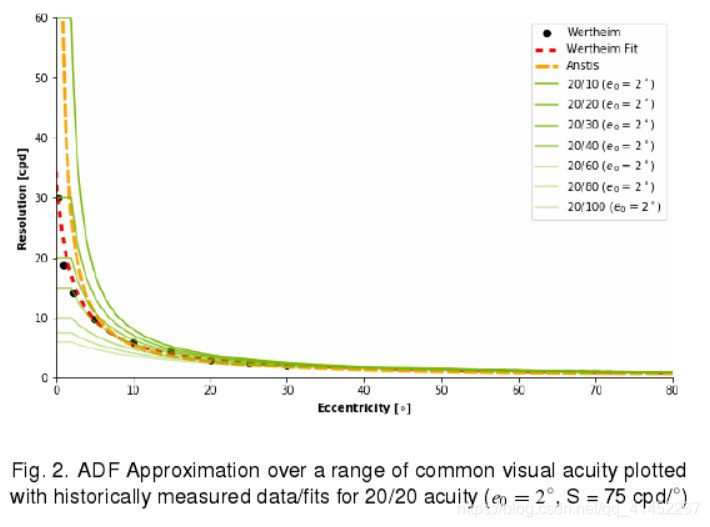Acuity Distribution Functions
Equation 1 provides a simple mapping between Snellen fraction and the maximum foveal acuity of a user in cycles per degree (cpd).

In order to completely specify a user’s visual acuity it is useful to consider more than just their foveal acuity. If the peripheral acuity requirements are not met, a display may present bothersome artifacts. In order to address visual acuity in a more holistic manner, the Acuity Distribution Function (ADF) is introduced. An ADF describes the angular resolution (in cycles per degree) as perceived by a user as a function of gaze eccentricity, or angular displacement from the center of gaze fixation (i.e. from the gaze direction).
If we make a simplifying assumption that we are only interested in the maximum guaranteed (minimum overall) resolution along any radial “slice” of gaze eccentricity, and that acuity is strictly decreasing with eccentricity, we can describe an arbitrary ADF as a monotonic decreasing function of the eccentricity of the display/gaze. While this model does not correctly match the human visual system which varies in acuity based on which radial angle is selected, and includes things like the blind spot, it does give us an effective way to classify displays by approximating the ADF of the user. One such approximation for an average user’s ADF over eccentricity(e) is the following function:

Where F refers to the foveal acuity (as calculated in Equation 1), S refers to the peripheral roll-off “slope” in cpd/◦, and e0refers to the width of the foveal region (assumed to be constant resolution). Analysis of historical data [3, 38] was used to determine a reasonable peripheral roll-off slope of 30 cpd/0.4◦or about 75 cpd/°. The resulting ADF is visualized for e0= 2◦over the range of common visual acuity, together with historical acuity measures from Wertheim [38] and Anstis [3] in Figure 2.

Paper:Toward Standardized Classification of Foveated Displays
标签:
相关文章
-
无相关信息
